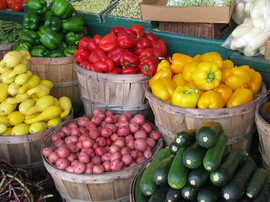 Less than two percent of Americans
today live on farms and ranches, contributing to a disconnect between food
producers and consumers. However, consumers have a growing interest in learning more
about where their food comes from and connecting with farmers and ranchers
in their region.
Regional food hubs manage the collection, distribution and
marketing of food products, primarily from local and
regional producers to
strengthen their ability to satisfy consumer demand. However, the lack
of distribution systems is one of the main roadblocks to local foods moving
into mainstream markets. NIFA-funded projects are addressing this food
distribution issue in food-insecure communities by creating new local food
hubs.
The Molokai Food Hub (MFH) addresses the food insecurity of its 7,000-person community on
the island of Molokai, Hawaii. An estimated 80-90 percent of the food in
Molokai grocery stores is imported via barge, and families bear the
transportation costs in high food prices. In addition, the high rate of obesity, diabetes, and other
chronic diseases among Native Hawaiian and Pacific
Island populations have been attributed to unhealthy dietary choices,
especially a lack of fresh fruits and vegetables. The food hub focuses on these
issues by providing outreach and education around buying, preparing, and eating
more local, fresh foods – which also increases demand for local food products. To help increase supply of local food
products, MFH offers training, support, production planning, and marketing for
island farmers.
A food hub in Foley, Ala., uses a local farmer and
fisherman market as a base for their food hub initiative. The operation, Fresh from Foley, teams up with local producers,
distributers and farmers to collect, package, and ship locally grown produce to
local restaurants, schools, and grocery stores.
Chicago’s Farmers for Chicago program assists low-income,
underserved populations by increasing the availability of high-quality, locally-produced,
and culturally-appropriate food throughout Chicago. Farmers for Chicago
provides resources for new urban farmers and the infrastructure they need to
grow and distribute locally grown produce year round.
Finally, Common Market Food, based in Philadelphia, works to
ensure that the food needs of all residents in the Philadelphia metropolitan
area are met and that local farmers have a viable alternative to the mainstream
food distribution network. The market connects wholesale customers to about 75
producers in New Jersey, Pennsylvania, and Delaware who deliver to almost 150 public and private schools, colleges and universities, hospitals,
workplaces, grocery stores, nonprofits, and faith institutions throughout the
Delaware Valley, six days a week.
For more NIFA impacts, visit nifa.usda.gov/impacts or the Land-Grant University Impacts
website. Send
us your NIFA-funded impacts at impactstories@nifa.usda.gov or share them with USDA_NIFA on Twitter #NIFAimpacts.
NIFA invests in and advances agricultural research, education and extension and seeks to make transformative discoveries that solve societal challenges.
|